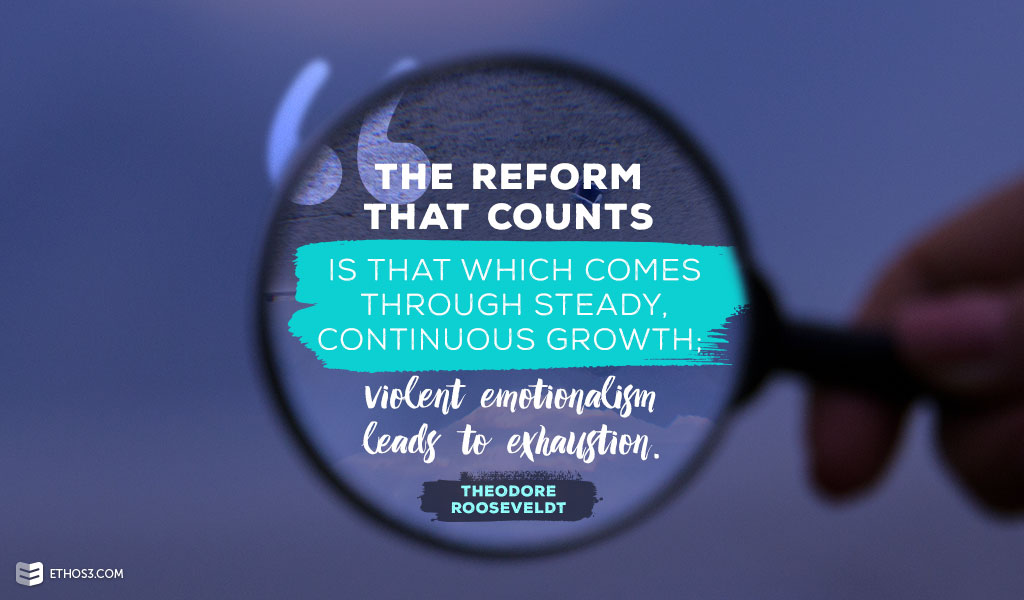Since President Donald Trump staked his claim on the political scene, he has established a reputation for attacking journalists and media outlets. From questioning the credibility of Megyn Kelly to claiming reporters misrepresented quotes and facts in stories about him, President Trump has initiated a personal reform of the news industry. During the Progressive Era in the United States, many individuals called for reform. From women’s suffrage and the direct election of senators to minimum wage laws and work regulations, activists and journalists alike strived to enact change in politics and business. Amid sensationalist reviews of events and policies delivered by influential members of the media and everyday protestors, President Theodore Roosevelt spoke out against the “mud-slinging” in a speech titled “The Man With the Muck-Rake.” While the present day “mud-slinging” can be seen in the words and actions of one person, Roosevelt addressed several groups of folks on their own missions for transformation. Here’s a public speaking analysis of his speech:
State Your Opinion
A man of Progressive ideals himself, Roosevelt was not immune to protesting the problems of the day. However, he did take a clear stance on the protest approach of the people he termed as “muck-rakers.” Borrowing from “Pilgrim’s Progress,” Roosevelt compared a particular set of Progressive protestors to men who only look down to the floor and refuse to look up to the entities and individuals providing them with services and offerings. While he approved of the war against evil, he called for a more concerted effort to provide constructive criticism. In other words, he preferred that any attacks be honest and straightforward.
“Expose the crime, and hunt down the criminal; but remember that even in the case of crime, if it is attacked in sensational, lurid, and untruthful fashion, the attack may do more damage to the public mind than the crime itself.” – Theodore Roosevelt
At the conclusion of his speech, he repeated his opinion that crimes should be exposed in the right way by addressing two components of a perfect reform: honesty and sanity.
Inform Through Analogy
An analogy is “a similarity between like features of two things, on which a comparison may be based.” Roosevelt incorporated an analogy of a painting to illustrate the negative impact a muck-raker’s pessimistic attitude has on society as a whole.
“If the whole picture is painted black, there remains no hue whereby to single out the rascals for distinction from their fellows. Such painting finally induces a kind of moral color-blindness; and people affected by it come to the conclusion that no man is really black, and no man is really white, but they are all gray.” – Theodore Roosevelt
Roosevelt could have simply said: “Muck-rakers are blurring the lines between good and evil by believing that people are inherently bad.” Yes, that description gets the point across much faster. But it isn’t half as interesting and engaging as Roosevelt’s analogy.
Structure with Theme
Through my public speaking analysis of “The Man With the Muck-Rake,” I noticed that Roosevelt was an expert at communicating a core theme through repetition. The crux of his speech relied on defining good versus evil, then adopting best practices for inciting reform. During the course of his 3,288-word talk Roosevelt said “good” 18 times and “evil” 22 times.

His audience was never at a loss when deciphering his intention for the speech. He was addressing them for a purpose and with a clear idea at the ready.
Prepare a Solution
Just as Roosevelt preferred the muck-rakers to offer up solutions for the problems they denounced, a presenter must prepare solutions to the problems they outline. Roosevelt introduced a couple initiatives towards the end of his speech.
“I feel that we shall ultimately have to consider the adoption of some such scheme as that of a progressive tax on all fortunes…” – Theodore Roosevelt
First, he explained his support for a progressive tax on income. Then, he introduced news about railway-rate legislation that Congress was working on at the time to deal with economic obstacles like interstate commerce.
For any public speaking opportunity you get, implement the strategies of Theodore Roosevelt when creating your presentation. Have an opinion and make sure it is communicated clearly and efficiently to your audience. Increase the retention of your message by engaging your audience through analogy and structure your messaging around a common theme. Finally, prove the problems exist and deliver meaningful solutions to them.
Public Speaking Analysis Articles From Our Archives:
Spiritual Inspiration: An Analysis of Jim Carrey’s Commencement Speech
Presentation Persona Spotlight: Donald Trump
Psychology + Laughs: An Analysis of Tim Urban’s “Inside The Mind of a Master Procrastinator”
